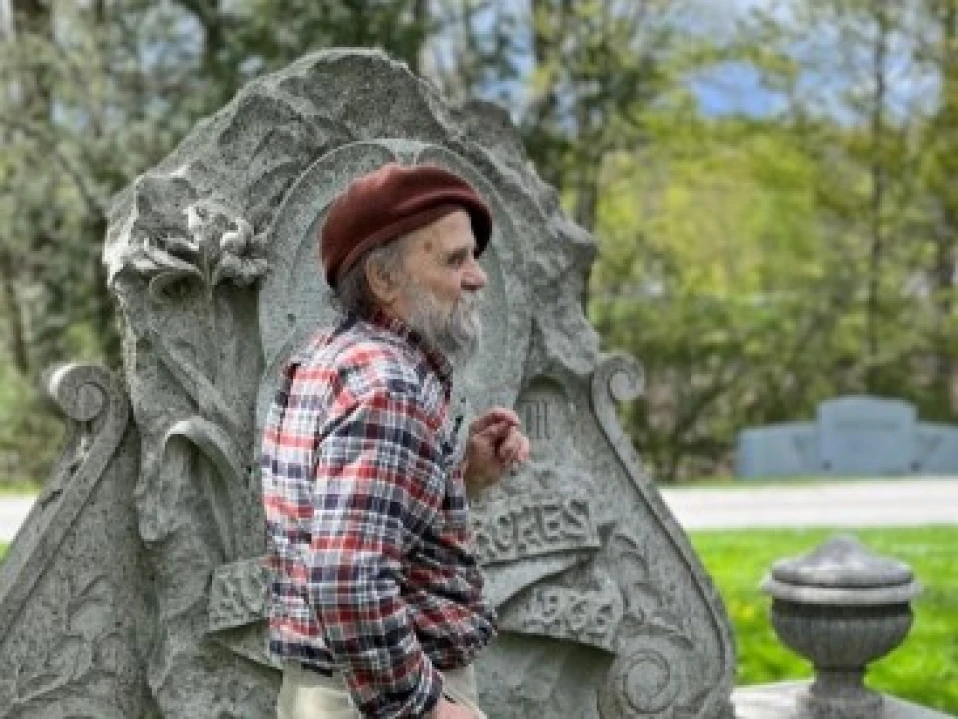On a glorious sunny spring day this past May, just before Mother’s Day, a group of Vermont Italian Cultural Association members and our guests gathered at the hilltop gates of Hope Cemetery in Barre, Vermont. We crowded close together encircling Giuliano Cecchi-nelli, the sole remaining Italian-born stone carver in Barre.
Coming from more than 20 generations of stone carvers who used traditional hand tools ra-ther than the pneumatic tools used today, Giuliano was a gracious host and was generous with the knowledge he’s gained over his lifetime as a stone carver. At 80 years old, he may be small in stature, but he is large in charm and personality.
He is the kind of person who leans in when you are in con-versation with him, both physically and relationally. Collectively, we could feel the privilege it was to be escorted through this unlikely art gallery by the re-nowned artist himself.
We spent the morning casually strolling from tombstone to tombstone as Giuliano de-scribed his creative process. He recalled to us that the early Italian carvers were unlike any others—so specialized were they in their workmanship that one carver would focus on the writing on a piece while another who specialized in carving flowers would finish the floral work on a piece. I know I wasn’t alone in admiring his innate talent to visualize the different dimensions and planes and how the highlights of each particular stone translated into different layers on the final piece. “I try to make people believe what I feel,” Giuliano stated endearingly. “It all comes from here.” His hand laid over his heart, each finger bent and calloused showing physical proof of a lifetime of carving. Interest-ingly, “Cecchinelli” means “blind.” It is fitting that his art comes not from what he sees as much as from what he feels.
Early on in the tour, a member asked Giuliano to describe the difference between the draftsman and the carver. This question interested me in particular, as my grandfather Delio Arioli spent his career as a draftsman in Barre. Walking around, I recognized many flowers and crosses I have seen in the original drawings I have of his. We learned from Giuliano the draftsman creates the “idea” on paper and the carver creates it on the stone. You can imagine that a two-dimensional drawing is much different from what the final piece becomes. “Working with the grain is everything,” Guiliano said about bringing the draftsman’s initial ideas to life.
While he didn’t specifically remember work-ing with my grandfather, he did remember other members of my family. At that moment I felt the incredible importance of attending VICA events like this. By connecting in this way, we strengthen our knowledge and un-derstanding of parts of our ancestors’ lives we may not have gotten to witness. Hope Ceme-tery was plotted at the turn of the 20th centu-ry, about the same time that the first Italian carvers arrived. Many of these carvers and draftsmen are buried here, under the same monuments they created. My grandfather is one of those.
According to Giuliano, part of the authenticity of a tombstone is the dirt and lichen that slowly grow on the piece over time. Tombstones should not be cleaned and kept pristine. “The patina develops and gives more dimension,” Giuliano says. “People always want it to be squeaky clean, but squeaky clean takes the dimension away.” This beauty was pointed out to us along the way, often on the backs of stones where the front had been cleaned and the backs left to the elements. Repeatedly Giu-liano expressed his preference for the “dirty” tomb-stones throwing in that he hopes no one ever cleans his tombstone. In fact, his tombstone exists already in Hope Cemetery. It depicts his wife, Julia, as a young girl and himself as a young man drag-ging a pile of sticks. As with the other true beauties he pointed out to us during the tour, his stone is rough carved showing the beautiful dimension of the grain of the stone.
If you get the opportunity to visit Hope Cemetery, I hope the sun is shining for you the way it was for us. I hope you will go and find one of Guiliano’s fa-vorite tombstones, the Marchesi Family stone. I hope you will imagine him working the grain with his hand tools the way his ancestors did generations before him and marvel at the intuition the carver must have had to anticipate the way light would bounce off the final piece. I hope you will breathe in the fresh hilltop air and feel humbled by this truly stunning spot, overflowing with artistry and workmanship. I am grateful to VICA for organizing this opportunity.



